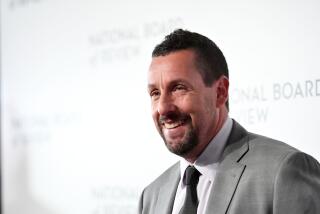Park Chan-wook: The South Korean director gets dialed in
Park Chan-wook likes the way blood looks through the camera lens of his iPhone – that rich texture and shock-effect red.
But Park’s no techno-savvy killer. He’s an award-winning South Korean filmmaker whose graphic horror-and-humor style has been likened to Quentin Tarantino’s. His latest project is remarkable not for its gore but for its camerawork that could prove a populist breakthrough in the highfalutin art of filmmaking.
FOR THE RECORD:
IPhone movie: A Jan. 15 article in Calendar about South Korean filmmaker Park Chan-wook’s use of an Apple iPhone 4 to shoot his latest short film, “Paranmanjang,” said the English title for the project was “Ups and Downs.” Although this is the direct translation for paranmanjang, the film’s makers are calling the project “Night Fishing.” The article also said Park added “a series of more sophisticated cameras for the scope and close-ups he sought.” The filmmakers added different lenses, not cameras. —
Park’s 30-minute fantasy film, “Paranmanjang” (“Ups and Downs”), which will have its theatrical premiere in Seoul on Jan. 27, was shot entirely with the latest version of Apple Inc.’s iconic smart phone, the iPhone 4.
For years, new technology such as digital cameras and off-the-shelf editing software has been turning filmmaking into a cheaper and easier venture. But few high-profile commercial directors have embraced mass-market hardware, gravitating instead toward bells and whistles like 3-D and other costly special effects.
But Park rolled the everyman’s dice. And he liked what he saw.
With the stodgy traditional cameras that often block a director from the actors replaced by the palm-sized mobile phone, Park said his eyes were opened to new possibilities in moviemaking.
“Everything seemed more alive, more real,” he said. “There was a certain coarseness, like making a documentary.”
With his goatee and slicked-back Michael Douglas mane of black hair, Park, 47, has a reputation for risk-taking in celluloid style and substance. His films employ lush cinematography to portray such disturbing images as petrified children, dentistry by hammer, and underwater surgery on an Achilles tendon.
Among his nation’s most acclaimed filmmakers, Park first achieved fame in 2000 with “Joint Security Area,” telling the tale of the Korean peninsula divided by war. Four years later, he won the Grand Prix at the Cannes Film Festival for “Old Boy,” the second installment of his so-called revenge trilogy and now a Korean cult classic. In 2009, his movie “Thirst” won the Jury Prize at Cannes.
Always on the hunt for new challenges, Park found a big one in the iPhone. The idea arose last fall just as he and his brother (and fellow director) Park Chan-kyong were set to begin filming a fantasy about a middle-aged fisherman who one day hauls a woman out of the water’s depths.
That’s when South Korea’s exclusive iPhone distributor offered to finance the $130,000 project if the pair agreed to use the device to make a theater-quality film.
Park’s initial plan was straightforward: He would use an average iPhone for the job, but add a series of more sophisticated cameras for the scope and close-ups he sought. And he would not use the device for any trick photography, such as attaching it to actors or miniature vehicles for point-of-view shots. “I wanted to use it just like I would any other camera,” he said.
But the five days of on-location shooting brought instant surprises. First off, the tiny smart phone looked oddly out of place attached to the huge dolly used to maneuver traditional cameras.
The device also introduced a new sense of freedom. “The actors said that using something almost invisible meant that they didn’t feel overwhelmed like they would by a regular camera,” Park said. “And for once, they said they could actually see the director,” who is usually huddled behind the oversized camera.
The iPhone even influenced camera angles. Park, usually meticulous with a normal single camera, was more freewheeling, employing as many as eight iPhones at once.
“We encouraged others to use their own iPhones during a shoot, people like the associate director, producer and even the actors’ manager,” Park said.
In the end, they had hours of extra footage. They compiled that, and some impromptu shots were used in the final version.
Even though his project used professional cameramen who were able to add sophisticated lenses to the iPhone, Park quickly came to what he considers a profound realization: With this device, anyone can make a professional-quality movie.
“People are familiar with the iPhone,” he said. “Many are obsessed with it. This is another way to use it.”
He hopes the smart phone will encourage the general public to play filmmaker. “Find a location, you don’t even need sophisticated lighting – just go out and make movies,” he said. “These days, if you can afford to feed yourself, you can afford to make a film.”
Through such Internet sites as YouTube, the results can be promoted by word of mouth. “The time is gone when you can only see films in theaters,” Park said. “It’s absolutely passed.”
Park is looking for an international distributor for “Paranmanjang,” which has already received positive reviews here. He may even use the device again for certain scenes or an entire low-budget project.
“But the technology changes so fast,” he said. “Who knows what’s going to be available next year?”
More to Read
Only good movies
Get the Indie Focus newsletter, Mark Olsen's weekly guide to the world of cinema.
You may occasionally receive promotional content from the Los Angeles Times.







